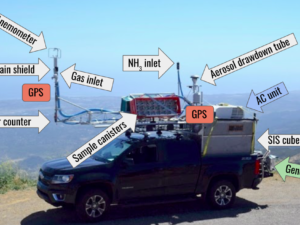Aug. 14, 2018. Santa Barbara, CA.
A common and affordable approach to natural gas leak detection and quantification is by Gaussian plume inversion of in situ concentration data, which assumes that the plume from an emission source spreads horizontally and vertically by atmospheric mixing from turbulence while drifting in the downwind direction. Plume inversion combines in situ concentration measurements with wind direction and speed to determine by best-fit optimization the plumes source and strength.
In the near field of the source, challenges arise because the plume has not uniformly diffused (it can be puffy), whereas in the far field, plume vertical diffusion may have reached the Planetary Boundary Layer (PBL), which caps the plume. This makes the plume inversion from difficult to impossible (i.e., the plume inversion cannot be solved uniquely) unless the PBL height is known.
Finding the PBL height by mobile surface in situ measurements can be done if topography (hills/mountains) and roads are available that are higher than the PBL, which can grow to thousands of meters during the day. At nighttime, the PBL can collapse to less than 100 m. As a result, the plume inversion approach is extremely difficult from evening through mid-morning (or later on many days); yet, the ideal time for urban surveys is nighttime when minimal traffic allows easier freedom of movement.
In a new strategic collaboration between Bubbleology Research International and Micro Pulse LiDAR, part of Hexagon, we are field testing the ability of the MPL mini aerosol lidar to provide real-time PBL height. AMOG uses real time data visualization to improve the survey strategy – allowing the driver to respond to the incoming information and alter the survey pattern. This effort will allow confident plume inversion and thus emission detection and quantification both during the day and at night, improving the efficiency, cost effectiveness, and accuracy of emission detection campaigns.
For more information, please contact: Ira Leifer (Ira.Leifer@bubbleology.com) or Justin Fisher (justin.fisher@hexagon.com).



